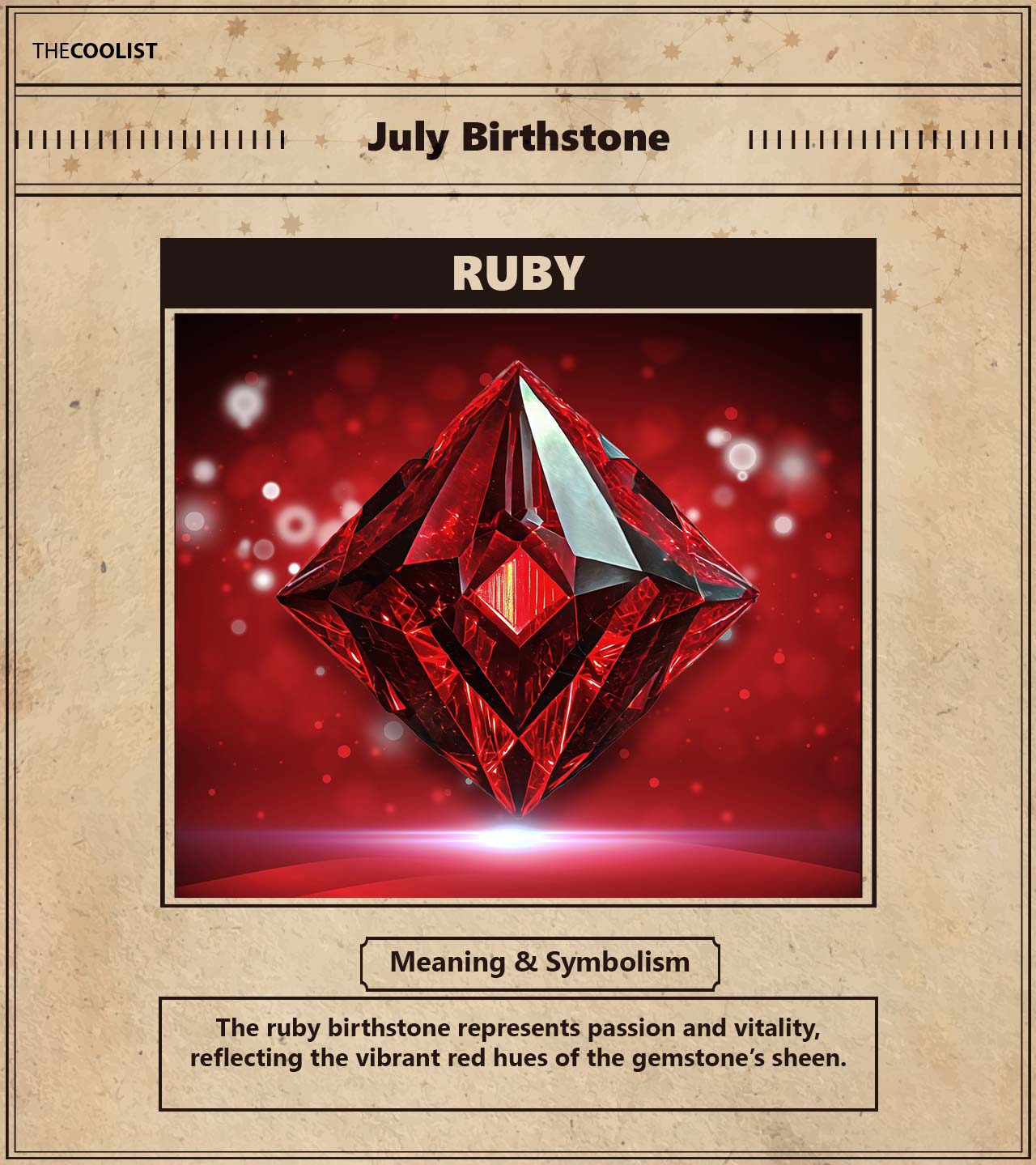The July birthstone is the ruby gemstone and represents passionate devotion, vibrancy, courage, and abundance. Rubies are renowned for their intensely deep red color that appears to illuminate from within. July’s birthstone symbolism and historical significance align with the personality traits of people born in July to benefit them by enhancing their wardrobe and promoting positive qualities.

The ruby’s blood-red color was believed to stimulate physical energy and invigorate the spirit, an attribute celebrated for enhancing circulation and vitality. Furthermore, rubies have been synonymous with strength and courage, prized by warriors for protection and resilience, and revered as symbols of wealth and nobility, adorning the regalia of aristocrats and royalty.
July’s ruby showcases a coloring and historical symbolism to mark the distinction between modern and traditional July birthstones. Traditionally, July birthstones included turquoise, onyx, and carnelian, each with unique qualities and cultural significance. The transition to ruby as the primary stone reflects its heightened status in contemporary times, diverging from the traditional assortment of gemstones.
The July birthstone’s deep red allure is a testament to the enduring legacy of rubies, embodying passion, vitality, and a rich combination of cultural and historical significance. Below, you’ll discover July’s birthstone meaning, history, and benefits, unraveling this cherished gemstone’s facets that continue to captivate those born in its month.
What does the July birthstone mean?
The July birthstone represents passion, vitality, strength, and wealth reminiscent of a ruby’s durability and color. Rubies showcase deep red hues and are emblematic of intense emotions and romantic commitment, making them a favored choice for expressing love and fidelity. This association with passion and love stems from historical beliefs and literary references, where rubies symbolized deep, unwavering affection. For example, in various cultural traditions and texts, rubies are celebrated as stones of the heart, representing enduring love and emotional depth.
July’s ruby birthstone symbolizes vitality and life force, which are also key attributes of the ruby. Its vibrant red color, reminiscent of blood, is believed to stimulate physical energy and invigorate the spirit. Gemologists value rubies for their aesthetic appeal and ability to enhance circulation and vitality. This connection between the ruby’s color and the essence of life is a recurring theme in historical gemstone literature, underscoring its role as a symbol of health and vigor.
The ruby further symbolizes strength and courage. Its association with bravery and resilience has been recognized since ancient times when warriors adorned themselves with rubies for protection and strength. For example, Gems and Gem Minerals by Oliver C. Farrington mentions rubies being used to protect against disease and harm. Lastly, rubies represent wealth and nobility. Rubies have a history of adorning the crowns and jewelry of aristocrats, signifying material wealth and regal status. The gemstone’s rarity and striking appearance have symbolized luxury and prestige.
The July birthstone has been cherished throughout history for its stunning beauty and its depth of symbolism. It’s a beacon of emotional depth, physical energy, courage, and wealth that remains a cherished gemstone for those born in July.

What is the difference between modern and traditional July birthstones?
Modern and traditional July birthstones differ in their coloring and historical symbolism. The traditional July birthstone included a variety of gemstones, consisting of turquoise, onyx, and carnelian. Turquoise, known for its distinct blue-green hues, has been valued for its protective qualities and is believed to bring peace and tranquility to the wearer. Onyx has a deep black appearance linked to strength and grounding energy. Carnelian, a stone with warm reddish tones, is traditionally thought to stimulate creativity and bolster courage.
The modern birthstone for July, established by the Jewelers of America in 1912, is the ruby, recognized for its deep red color symbolizing passion, prosperity, and power. Believed to boost vitality and amplify personal energy, rubies are also associated with attracting love and enhancing romantic connections, linked to the heart chakra in metaphysical beliefs. This transition to ruby as July’s primary birthstone marks a shift in cultural preferences and gemological understanding, contrasting with the traditional variety of stones like turquoise, onyx, and carnelian.
What are the alternate birthstones for July?
The three alternate birthstones for July are spinel, carnelian, and sapphire. Spinel is a modern alternative, celebrated for its wide color range, including captivating reds that cause it to be mistaken for its more famous counterpart, the ruby. Spinel is known as “the daughter of ruby” because red spinel shares similar revitalizing properties, heralded for bolstering renewal and inner strength. It is an excellent choice for those seeking to rekindle their zest for life.
A second alternative for July’s birthstone is Carnelian, which radiates with warm, reddish-orange tones, occasionally veering into brownish hues. This gemstone is praised for enhancing courage, motivation, and creativity, making it an ideal stimulant for artistic expression. Carnelian’s versatility in jewelry, from beaded pieces to cabochon settings and intricate carvings, makes it a vibrant complement to any ensemble.
A third alternative to ruby is the guardian angel stone sapphire, which offers a serene blue that contrasts with the fiery tones of the other July stones. Sapphire has qualities that complement the benefits provided by July’s gemstones, such as wisdom and divine favor. Together, these stones merge attributes of each other and their ruby counterpart.
Is there a July zodiac birthstone?
Yes, July has two zodiac birthstones with ruby for Cancer and peridot for Leo. The ruby resonates with Cancerian energy, a zodiac sign that exhibits qualities such as emotional depth, intuition, nurturing, and protective instincts. As a Cancerian native, wearing the Ruby birthstone is a protective and therapeutic talisman. It filters through the negative emotions that withhold the potential for your positive traits to shine through. Therefore, the July zodiac birthstone enhances the strengths of Cancer, influencing individuals born under the sign of Cancer.
Transitioning into Leo, peridot takes the stage, harmonizing with Leo’s vibrant and fiery energy. This bright green gem is said to bring out the regality and warmth of Leos, bolstering their natural leadership and zest for life. Both stones complement and enhance the distinct characteristics of their respective zodiac signs in July.
What color is July’s birthstone?
July’s ruby birthstone is a deep, vibrant red, symbolizing passion, vitality, and wealth. The most coveted rubies boast a rich, pure red known as “pigeon’s blood,” a term that reflects the stone’s intense color and exceptional clarity. This striking red distinguishes rubies as one of the most desired gemstones throughout history, frequently featuring in royal crowns and regalia. The tradition of valuing this deep red continues, solidifying the ruby’s status as the epitome of July’s birthstone. Conversely, the modern alternative for July, carnelian, offers a palette ranging from warm reddish-brown to orange, symbolizing life, energy, and the sun’s warmth. Carnelian complements the fiery ruby with its own earthy and vibrant tones.
What is the July birthstone crystal shape?
The July birthstone comes in the following four cuts to enhance its brilliance and forms in a hexagonal structure.
- Round: The classic round cut features a circular shape with numerous facets that maximize the ruby’s brilliance and sparkle. The round cut is versatile and widespread in various types of jewelry, including rings and earrings.
- Oval: The oval shape elongates the appearance of the ruby and maximizes its surface area, making the color and clarity of the gemstone more prominent. It’s a popular choice for statement pieces like pendants and cocktail rings.
- Cushion: Combining a square cut with rounded corners, the cushion cut offers a unique, vintage appearance. Its soft edges and significant facets enhance the ruby’s luster and depth of color.
- Cabochon: The cabochon cut is characterized by its polished, rounded top and flat or curved base that effectively highlights the asterism star-like effect of the ruby.
The ruby’s crystalline structure, primarily hexagonal, is defined by the orderly arrangement of atoms within its lattice. This structure manifests as a six-sided prism and pyramid, providing uniformity when viewed from different angles due to its symmetrical nature.
Additionally, rubies can exhibit a trigonal crystal shape characterized by threefold rotational symmetry, offering a consistent appearance at 120-degree intervals. The tabular hexagon is where rubies develop into flat, plate-like structures. This shape results from the internal atomic arrangement of corundum, the mineral family to which rubies belong, guiding their external growth and favoring hexagonal forms, including prismatic shapes. These crystal structures contribute to the ruby’s unique physical properties and aesthetic appeal.
What’s the history of the July birthstone?
The July birthstone boasts a history as a protective talisman that aided warriors and evokes passion. Rubies have been revered across various eras and civilizations for their deep connection to the sun and use as talismans of protection and strength. Their natural luminescence gives the impression of an internal light source, further enhancing their mystical allure and leading many to believe they contained their light. For example, Symbols of Magic: Amulets and Talismans by Clifford Lindsey Alderman describes lore telling of rubies’ power to dull and brighten their shimmer.
The ruby is known as “ratnaraj” or “king of gems” in ancient Hindu culture and was esteemed for its supposed abilities to bestow good health, wealth, and success. This deep red gemstone was also a staple in ancient warfare, especially among Burmese warriors. They believed that embedding rubies in armor or carrying them would impart invincibility, a testament to the stone’s protective and empowering properties.
During the Middle Ages and the Renaissance, rubies symbolized wealth and power. They were a favorite among royalty and the elite, often featured in regal crowns, opulent jewelry, and ceremonial objects, signifying high status and authority. For example, Queen Elizabeth II’s Boucheron Ruby Set Belle Époque Necklace.
The ruby’s lasting appeal as a symbol of power and prosperity is enhanced by its natural luminescence, underscoring its status as a gemstone of both historical significance and enduring beauty.
This mystical connection is echoed in an 1870s poem published in Tiffany & Co., where rubies are celebrated as the birthstone for July, highlighting the passion they elicit. The Jewelers of America further cemented this association by officially listing ruby as the July birthstone in their standardized list. This inclusion on the 1912 list is a testament to the ruby’s enduring legacy and revered status across centuries, firmly establishing it as a cherished gem for those celebrating July birthdays.
Where is the July birthstone found?
July’s birthstone is predominantly found across Asia, Africa, and occasionally in North America. Asia stands as the most notable region for ruby extraction. Myanmar is particularly famous for its high-quality “pigeon’s blood” rubies, especially from the Mogok Valley. Neighboring Thailand has historically been a hub for trading and enhancing rubies, while Cambodia’s Pailin region is known for its deep red stones.
Africa offers vibrant rubies from countries like Mozambique, known for its newer but significant deposits, and Tanzania, which provides rubies rich in color. Off the coast of Africa on Madagascar, rubies are found that are appreciated for their clarity and hue. North America’s contribution is more modest, with some ruby deposits located in the United States, particularly in Montana, known for producing sapphires and rubies in various colors. Each source brings its unique touch to the global ruby market, ensuring a diverse selection for those seeking to adorn themselves with July’s illustrious birthstone.
July birthstone chart
Below is a chart that explains the main attributes of July birthstones.
| July birthstones | |
| Modern | Ruby |
| Traditional | Turquoise, onyx, and carnelian |
| Zodiac | Ruby (Cancer) and peridot (Leo) |
| Meaning | Passion, vitality, strength, and wealth |
| Color | Vibrant red |
| Historical significance | Provides light |
What are the July birthstone personality traits?
The following are five of the July birthstone personality traits that relate to the ruby crystal.
- Passionate: Rubies are associated with passion and intense emotions, which is unsurprising that those born in July are expressive and deeply engaged in their pursuits.
- Courageous: The vibrant red color of the ruby is linked to qualities of strength and courage. July-born individuals are perceived as brave and resilient in adverse times, channeling the birthstone’s qualities.
- Affectionate: Rubies are associated with love and affection and are deeply connected to their emotions. Their warm-hearted and affectionate ways align with the fiery hues of ruby crystals.
- Protective: Rubies are seen as protective stones, guarding against injurious energy and caustic people who wish you ill intent. Hence, people born in July exhibit a nurturing yet fiercely protective nature, especially toward loved ones.
- Leadership: The deep red hue of the ruby embodies power and authority, suggesting that July-born individuals have inherent leadership qualities. They are believed to exhibit confidence and determination, often inspiring and guiding those around them.
Are there benefits to wearing a July birthstone?
Yes, wearing the July birthstone has three main benefits: emotional well-being, protection against negativity, and enhancing vitality. Donning rubies bolsters emotional well-being, enhancing the wearer’s mood and contributing to a more vibrant and energetic mindset. They’re said to improve emotional well-being, contributing to a happier and more energetic disposition and fostering a positive perspective on life. As protective talismans, rubies are thought to dispel negative energy and shield against others’ malevolent wishes. Additionally, rubies are credited with boosting vitality. They’re believed to support circulation and nerve function, purportedly energizing the body and fostering a sense of ebullience and positive energy.
What happens after wearing rubies?
You may encounter an array of perceived benefits in line with gemological beliefs and birthstone lore after wearing rubies. These vibrant gemstones amplify passion, love, and vitality, potentially invigorating energy levels. Historically revered as protectors, rubies offer a sense of grounding, safeguarding wearers from negativity and misfortune.
Additionally, there’s a belief that rubies can foster creativity by stimulating the heart and crown chakras, the energy centers associated with emotions and the intellect, thus enhancing the flow of creative ideas and thought processes. For example, the ruby aligns with July’s numerology equivalent, the number 7. The number 7 and ruby gems both feel a connection with spiritual intelligence to kickstart the creative process. While these experiences are steeped in tradition rather than empirical science, they reflect the enduring fascination with the symbolic power of rubies.
Who should not wear rubies?
Those born under malefic planets should not wear rubies. Destructive planets include Saturn and Mars, which are believed to interfere with Capricorn, Aquarius, and Aries. The energies of the ruby gemstone do not mesh well with the internal energy of these zodiac signs. Furthermore, western astrologers advise Virgos, Gemini, or Libra ascendants not to wear rubies because there is an animus connection between the sun and the planetary rulers of these natives. However, personal beliefs and customs may entice you to wear rubies despite the correlation with negative energies stemming from Saturn and Mars. It’s important to maintain positivity to combat any negative emotional toll that comes your way, mystical or otherwise.
| Further reading on birthstones | |||||||||||
| January | February | March | April | May | June | August | September | October | November | December | |

